Table Of Contents
- 1Introduction
- 2What Is a Student Management System (SMS)?
- 3What Does a Student Management Software Do?
- 4Key Features of Student Management Software
- 5Benefits of Student Management Software for Higher Education
- 6Why Student Management Tools Are Essential for Schools
- 7Top 15 Student Management Software Solutions
- 8Category 1: Best for Large Districts & K-12 Institutions
- 9Category 2: Best for Private, Charter & Mid-Sized Schools
- 10Category 3: Best for Higher Education & Specialized Needs
- 11How Higher Education Institutions Can Choose the Right Student Management Tools
- 12Conclusion
Introduction
The global market for school management software, which includes centralized student information systems, was valued at around USD 15.18 billion in 2024 and is expected to grow to USD 41.46 billion by 2032. This rapid growth highlights the increasing reliance of educational institutions on digital solutions to streamline administrative tasks, enhance student support, and improve overall campus efficiency. With the right student management tools, schools and universities can simplify operations, foster better communication, and make data-driven decisions that positively impact both staff and students.
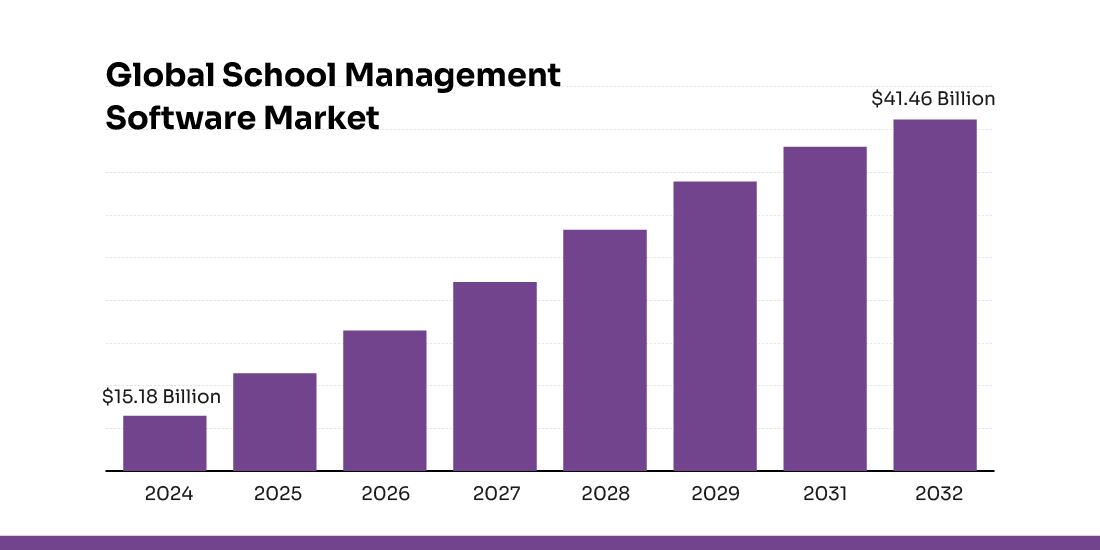
Source: Verified Market Research
What Is a Student Management System (SMS)?
A Student Management System (SMS) is an advanced digital platform designed to support educational institutions in managing the full student lifecycle — from recruitment and enrollment through graduation and beyond. Unlike a traditional Student Information System (SIS), which primarily handles administrative records and compliance, an SMS offers more — with tools for student engagement, real-time tracking, and proactive support.
Key features typically include:
- Streamlined enrollment and registration, to simplify admissions
- Centralized student profiles that bring together academic, personal, and engagement data
- Course scheduling and academic record management
- Grade tracking, progress monitoring, and transcript generation
- Financial aid processing and tuition administration
- Compliance and accreditation reporting
- Communication tools for students, parents, and staff to foster engagement
These features help institutions reduce administrative bottlenecks, unify data, and provide timely, personalized support to students. For instance, research shows that only around 60% of students at four-year institutions complete a degree within six years, highlighting the importance of integrated systems that enable proactive academic and student support.
What Does a Student Management Software Do?
A Student Management Software helps educational institutions streamline administrative tasks, improve organization, and enhance student support. It centralizes student data—such as records, schedules, grades, and attendance—allowing schools to operate more efficiently and make data-driven decisions that improve student outcomes.
- Simplify Administration: Automate attendance tracking, transcript generation, and other time-consuming tasks.
- Enhance Student Success: Identify academic challenges early and provide timely interventions.
- Manage Health Records: Maintain up-to-date student health information for better care and safety.
- Organize Class Schedules: Help teachers, students, and parents stay coordinated and informed.
- Track Grades: Monitor academic performance and share progress reports seamlessly.
- Generate Behavior Reports: Record and address behavioral issues effectively.
- Maintain Student Transcripts: Securely store complete academic histories for easy access and reporting.
- Monitor Attendance: Track attendance patterns and address absenteeism proactively.
- Offer Parent & Student Portals: Provide families with real-time access to grades, schedules, and school updates.
- Support Compliance Reporting: Simplify state or provincial reporting to ensure accurate funding and compliance.
Key Features of Student Management Software
A comprehensive student management software acts as a powerful student support management tool, enabling schools to manage academic and administrative functions with greater efficiency. These systems bring together multiple features that automate routine tasks, streamline operations, and enhance student support across the institution.
Here are the key features of a strong student management system:
Centralized Student Database
A centralized student database forms the backbone of any effective school management system. It securely stores complete student information—personal details, academic records, attendance, health data, and disciplinary history—all in one place. This eliminates the inefficiency and risks of scattered or manual record-keeping. Notably, U.S. reports show that K–12 systems holding student and staff data have faced over 3,700 breaches, exposing 37.6 million records to date, underscoring the need for secure, unified data management.
Automated Attendance Tracking
Modern student management solutions streamline attendance through automated tools such as biometric authentication, mobile check-ins, and real-time absence alerts. These features reduce manual effort, improve accuracy, and help schools respond quickly to attendance issues. A recent analysis showed that nearly 35% of students in a major U.S. district were chronically absent in 2023–24, underscoring the need for precise monitoring and early intervention.
Advanced Academic Management
Modern student management tools go far beyond basic grade entry. They enable standards-based grading, competency tracking, and learning analytics that give educators deeper visibility into student performance. These insights help identify learning gaps early and guide targeted interventions. A UPCEA survey reports that 50% of higher-education institutions now use AI-driven outcomes tracking, underscoring the growing adoption of these advanced academic tools.
Comprehensive Financial Management
Integrated financial management modules streamline tuition billing, fee collection, and payments for services such as transportation or meal plans. By centralizing financial processes, institutions reduce manual errors and increase transparency. Automated workflows also ease administrative workload and improve accuracy.
Benefits of Student Management Software for Higher Education
Higher education institutions today face rising challenges — from declining enrollments to changing student expectations and the demand for measurable learning outcomes. A modern student management system provides colleges and universities with the data, insights, and flexibility needed to address these pressures effectively.
Enhances Administrative Efficiency
By automating routine tasks and connecting student information across departments, institutions can significantly reduce manual work. Processes become faster, more accurate, and less error-prone. Staff members save valuable time that can be redirected toward student support. Tools like EDMO’s Document Intelligence take efficiency a step further by instantly analyzing transcripts, SOPs, and other student documents, providing actionable insights that speed up admissions and academic evaluations.
Improves Student Engagement
Student management tools offer communication features, self-service portals, and personalized alerts that keep students informed and involved. These tools help ensure learners receive timely updates and stay on track with deadlines. Research shows that institutions using strong engagement systems saw a 20% rise in retention and up to a 30% increase in engagement rates. With EDMO’s Conversation Intelligence, schools can analyze student interactions, identify concerns early, and deliver personalized guidance, further enhancing engagement and ensuring that no student falls behind.
Supports Data-Driven Decision-Making
Real-time analytics give educators and administrators clear visibility into student performance and institutional trends. Early detection of challenges enables timely interventions that improve outcomes. Reliable insights strengthen planning, retention efforts, and academic strategies. Recent reports show that around 70% of North American higher-ed institutions now use cloud-based student information systems, highlighting the growing focus on analytics-driven management.
Why Student Management Tools Are Essential for Schools
Today’s schools are complex environments with many academic, administrative, and communication tasks. Managing these through separate systems can lead to inefficiency and mistakes. A centralized system helps organize operations, automate processes, and make daily management much smoother.
Centralized Administration
A Student Management Software unifies student records, attendance, grades, and schedules into one centralized platform. This eliminates the need to manage multiple disconnected tools and significantly reduces manual workload. With streamlined data entry and improved accuracy, administrative efficiency increases. Industry insights show that over 65% of schools globally use digital systems for admin tasks, and 54% use them for automated attendance and grading.
Enhanced Communication and Collaboration
Strong communication between teachers, parents, and students is essential for a healthy learning environment. A school management system strengthens this connection with real-time notifications, digital progress reports, and in-app messaging that keeps everyone informed. It promotes transparency by allowing parents to follow their child’s academic journey and digital behavior responsibly. According to one report, 74% of institutions using an SIS benefit from real-time digital attendance tracking, showing the value of automated communication tools.
Data-Driven Decision Making
Modern Software provides real-time analytics on attendance, performance, and behavior, helping schools make informed decisions that directly improve student outcomes. These insights enable early identification of learning gaps and support timely academic interventions. As digital systems become strategic assets, 57% of higher-education leaders now view AI as a strategic priority, up from 49% the previous year.
Improved IT and Device Management
For IT teams, an SMS simplifies user and device management across the school’s digital ecosystem. It ensures secure access, smooth integration of tools, and proper monitoring of classroom technology use. This strengthens digital safety practices and helps protect students from online risks. A government report found that 60% of secondary schools experienced cybersecurity breaches in the past year, emphasizing the need for stronger digital oversight and disciplined IT management.
Top 15 Student Management Software Solutions
Selecting the right system can significantly improve how schools and colleges handle academic, administrative, and communication workflows. With the help of advanced student management tools, institutions can streamline data, enhance collaboration, and make more informed decisions. Whether you’re managing a large K–12 district, a private school, or a higher education campus, choosing the best student management software ensures smoother operations and stronger student support.
Category 1: Best for Large Districts & K-12 Institutions
These platforms are built for large-scale school networks, district administrations, and multi-campus K-12 systems that require advanced scalability, strong compliance management, and seamless departmental integration.
PowerSchool
PowerSchool is one of the most widely used K-12 management platforms globally, serving over 50 million students across 90+ countries. It offers an integrated suite of solutions covering Student Information System (SIS), Learning Management (via Schoology), HR, Finance, and Analytics — all within a unified interface.
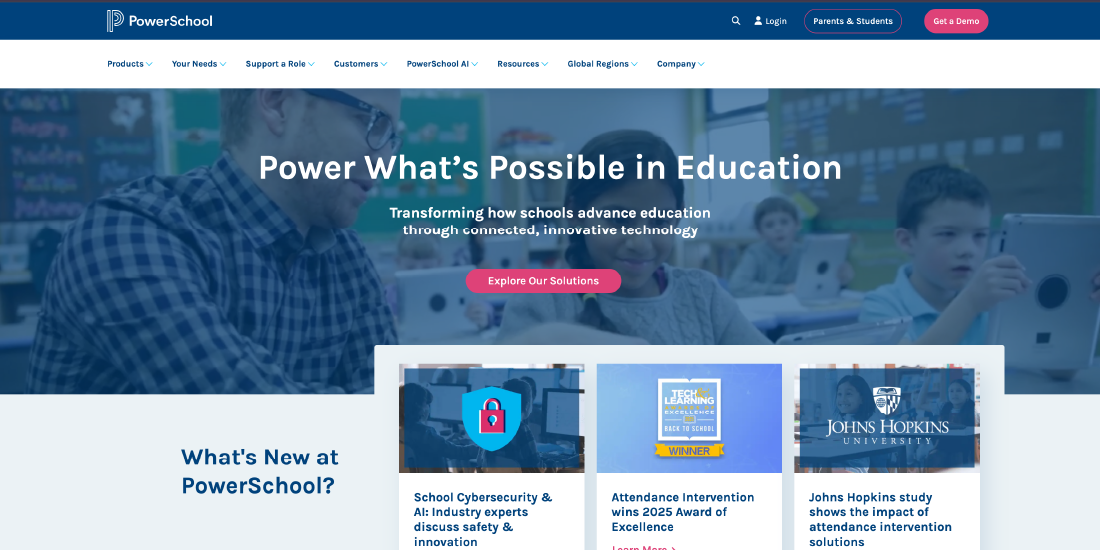
Key Features:
- Built-in LMS (Schoology) with curriculum management and grading tools
- Advanced data analytics for performance tracking and compliance reporting
- Supports state-specific education standards and integrations with third-party edtech tools
Best For:
Large K-12 districts and consortia seeking a comprehensive, enterprise-grade ecosystem for managing students, staff, and operations.
Pricing Model:
Custom quote based on required modules, integrations, and total student enrollment.
Infinite Campus
Infinite Campus is a powerful SIS trusted by over 2,000 school districts across the U.S., offering a real-time, centralized database that eliminates data silos. It supports seamless communication between administrators, teachers, parents, and students while maintaining compliance with state reporting standards.
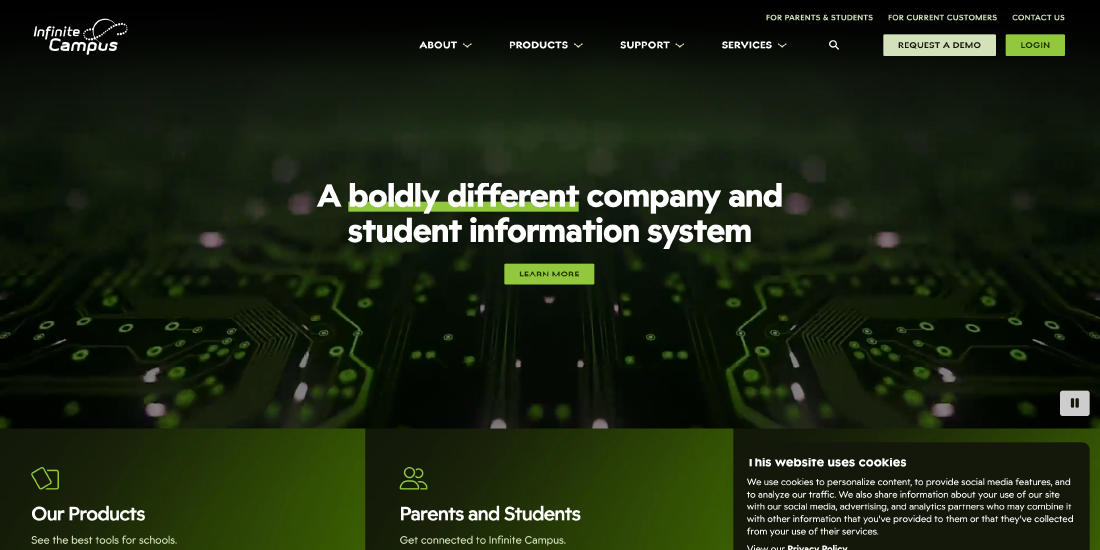
Key Features:
- Real-time data synchronization and dynamic reporting
- State compliance tools for accurate record management
- Integrated parent and student portals with instant access to attendance, assignments, and grades
Best For:
Large and mid-sized K-12 districts needing a scalable, compliant SIS with centralized control and real-time insights.
Pricing Model:
Custom quote depending on district size, feature selection, and integration requirements.
Skyward
Skyward combines student information management with enterprise resource planning (ERP) capabilities, making it a dual-purpose platform ideal for both administrative and academic operations. It is used by 2,500+ school districts worldwide, streamlining everything from gradebooks to payroll.
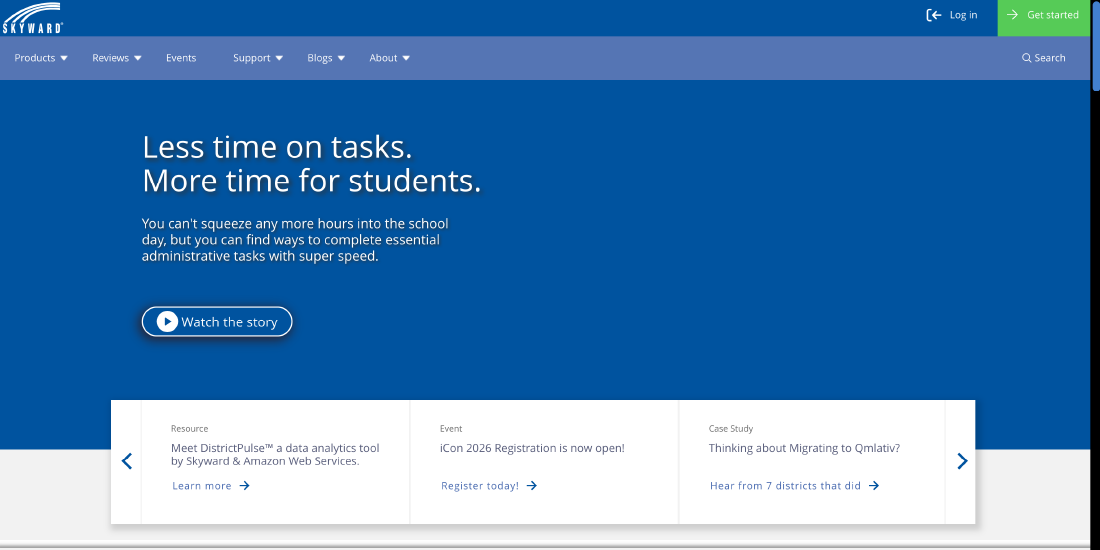
Key Features:
- Unified SIS + ERP modules for HR, payroll, and finance
- Intuitive dashboards for real-time data visualization
- Family Access portal for enhanced school–home communication
Best For:
Public schools and districts looking for a single system that handles both student data and back-office functions such as HR and accounting.
Pricing Model:
Custom quote tailored to institution size, selected modules, and deployment model (cloud/on-premise).
Frontline Education
Frontline Education specializes in human capital and operations management within K-12 settings. It offers comprehensive tools for staff recruitment, professional development, substitute management, and special programs — all linked to student outcomes.
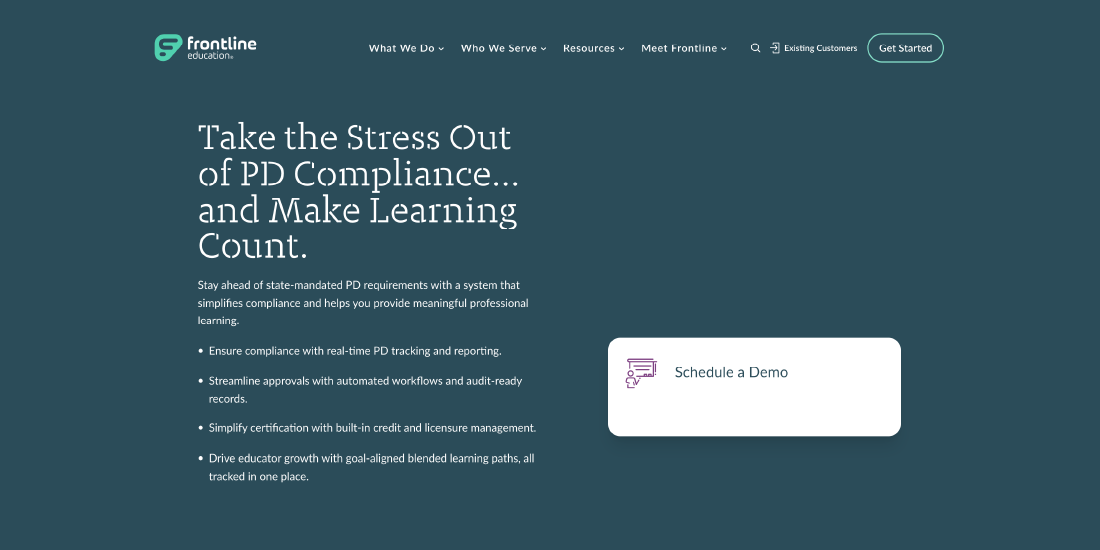
Key Features:
- HR and workforce analytics for staff optimization
- Absence management and professional learning tracking
- Special program and compliance management for special education (SPED) and RTI
Best For:
Districts aiming to enhance HR efficiency, improve teacher retention, and optimize operational workflows alongside student data management.
Pricing Model:
Quote-based, depending on staff size, selected modules, and integration needs.
Alma
Alma is a modern, cloud-based SIS designed for ease of use and flexibility. With a user-friendly interface and integration with Google Classroom, Canvas, and Clever, it bridges administrative simplicity with classroom engagement.
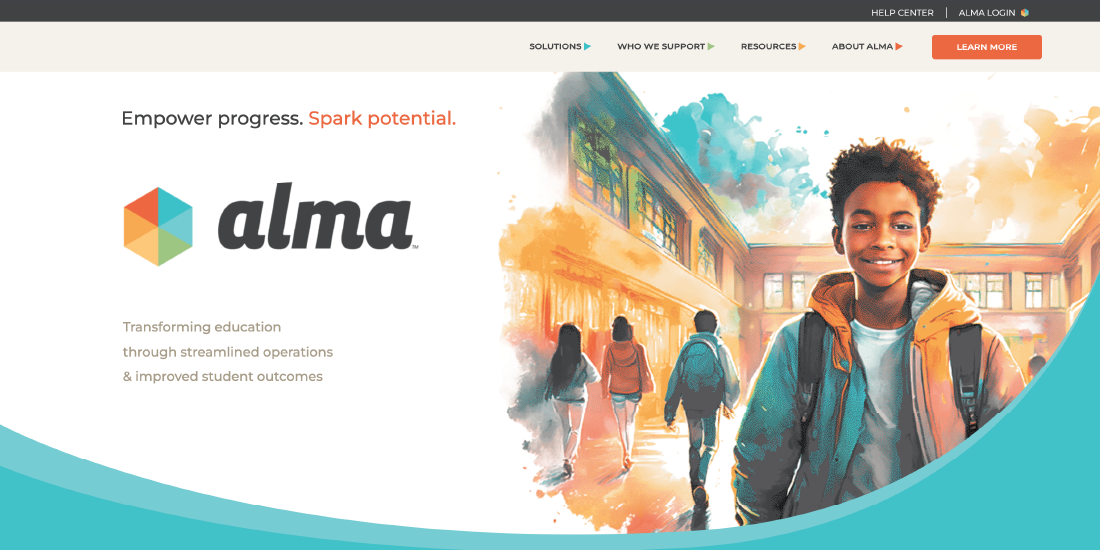
Key Features:
- Automated scheduling and enrollment management
- Advanced gradebook and progress-tracking tools
- Strong parent–teacher communication features
Best For:
K-12 schools and mid-sized districts looking for an intuitive, modern SIS with seamless integrations and simplified operations.
Pricing Model:
Custom pricing based on the number of students, selected features, and deployment model.
Category 2: Best for Private, Charter & Mid-Sized Schools
These platforms are designed for small to medium-sized private and charter schools that need efficiency, simplicity, and affordability.
Gradelink
Gradelink is a cloud-based Student Information System built for simplicity and speed. It handles key administrative functions such as grading, attendance, scheduling, and parent communication — all within a single, intuitive dashboard.

Key Features:
- Rapid deployment with minimal training required
- Automated attendance, grading, and progress tracking
- Parent and student portals for real-time engagement
Best For:
Small to mid-sized private or charter schools seeking a straightforward SIS that’s easy to adopt and manage.
Pricing Model:
Per-student monthly pricing with predictable scalability as enrollment grows.
Blackbaud Education Management
Blackbaud Education Management is a robust platform purpose-built for private and independent K-12 schools, connecting academics with admissions, finance, and fundraising functions.
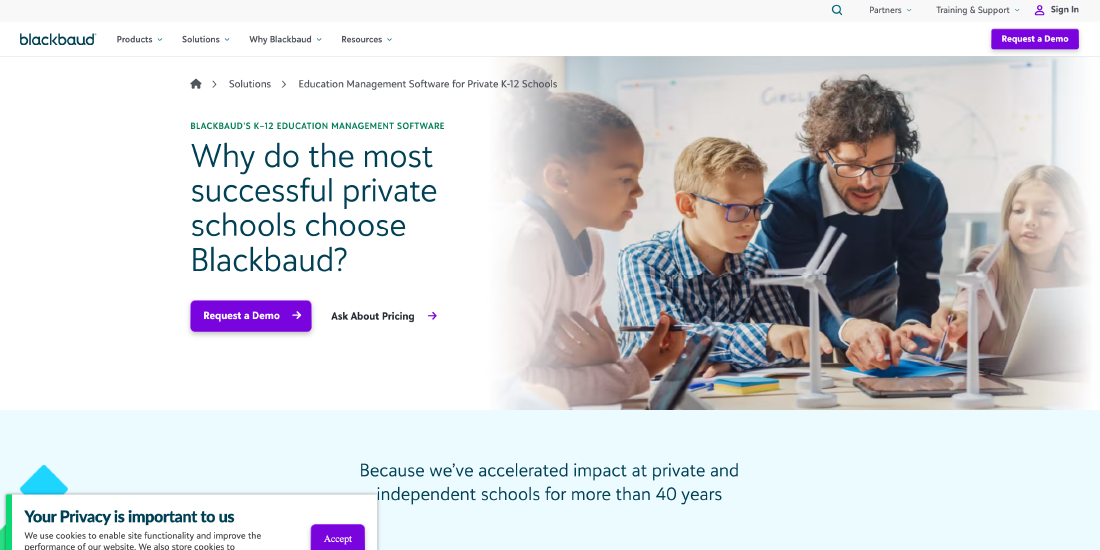
Key Features:
- Integrated financial aid, billing, and enrollment management
- CRM tools for donor and alumni relationship management
- Analytics for performance tracking and institutional insights
Best For:
Independent and private schools seeking to unify academic, financial, and community management under one system.
Pricing Model:
Tiered pricing based on modules and institutional size.
QuickSchools
QuickSchools offers a modular and flexible SIS that allows schools to pay only for the features they need. Its cloud-based system supports everything from billing and attendance to report cards and scheduling.

Key Features:
- Modular pricing structure for budget control
- Easy-to-use interface with drag-and-drop tools
- Built-in communication and grade tracking features
Best For:
Budget-conscious small to mid-sized schools looking for a customizable and scalable system without complex setup.
Pricing Model:
Per-student, per-month pricing with multiple subscription plans.
MySchoolWorx
MySchoolWorx is a lightweight cloud-based SIS designed to simplify daily school operations and strengthen parent-teacher communication. It offers an all-in-one dashboard that streamlines attendance, grading, and progress tracking.
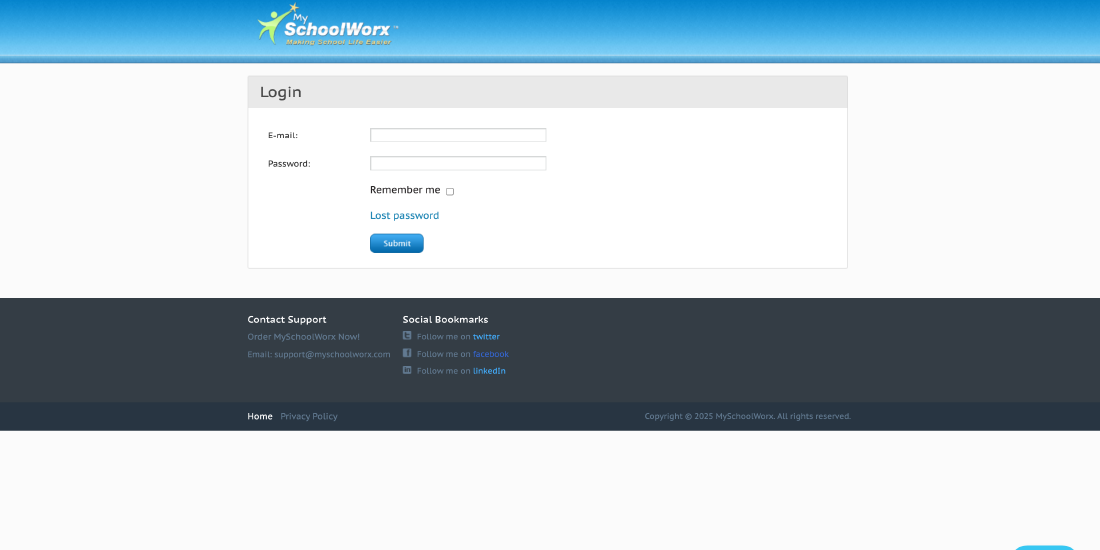
Key Features:
- Intuitive dashboard for teachers and administrators
- Real-time parent engagement and mobile access
- Simplified workflow management for small teams
Best For:
Small, private, and faith-based schools that prioritize strong communication and daily operational simplicity.
Pricing Model:
Custom quote based on enrollment and institutional needs.
DreamClass
DreamClass is a modern, web-based SIS designed for hybrid and flexible learning environments. It simplifies class scheduling, enrollment, and financial management while offering a clean, intuitive interface suitable for smaller institutions.

Key Features:
- Automated enrollment and fee tracking
- Timetable and session scheduling tools
- Cloud-based design with strong data security
Best For:
Micro-schools, specialty academies, and training centers that need an affordable yet flexible platform for hybrid learning.
Pricing Model:
Tiered subscription based on the number of students and selected modules.
Category 3: Best for Higher Education & Specialized Needs
These platforms are designed for universities, international colleges, and institutions that require robust ERP, analytics, and LMS capabilities. They provide advanced reporting, scalability across multiple campuses, and integration with external systems such as finance, HR, and CRM tools.
Ellucian Banner
Ellucian Banner is a comprehensive ERP platform trusted by thousands of higher education institutions worldwide. It supports the entire student lifecycle — from admissions and financial aid to academics, HR, and alumni management — all through an integrated system.

Key Features:
- Enterprise-grade scalability with cloud deployment options
- Full integration of academic, HR, and finance modules
- Advanced analytics for student retention and performance
Best For:
Large universities and multi-campus institutions that require a secure, enterprise-level ERP system.
Pricing Model:
Custom enterprise quote based on scope and deployment model.
Canvas LMS
Canvas by Instructure is one of the world’s leading learning management systems, supporting hybrid and online learning for K-12 and higher education. It offers an open, extensible platform with deep analytics and over 400 third-party integrations.
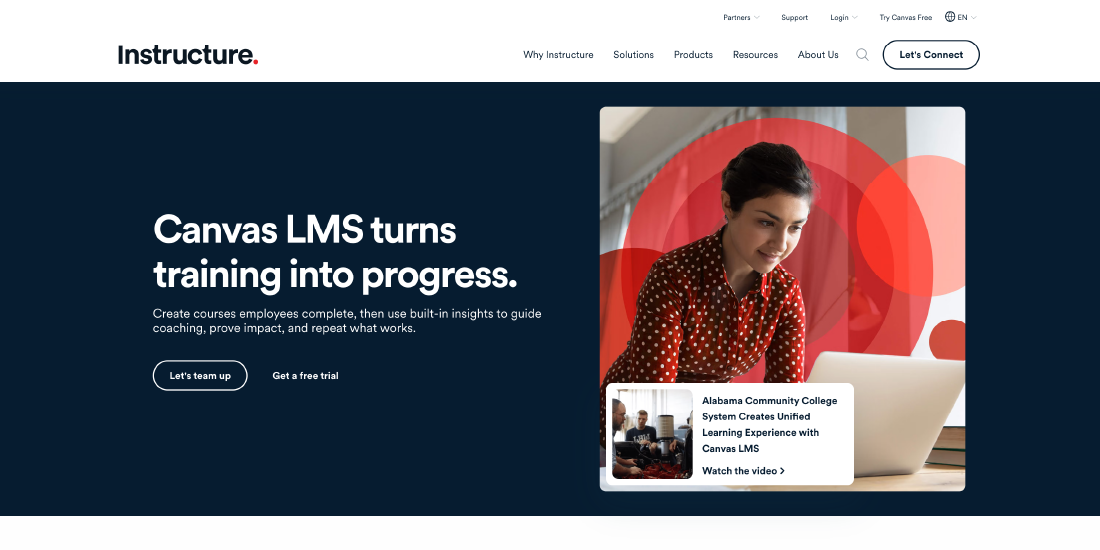
Key Features:
- Supports synchronous and asynchronous learning models
- Deep integration with Google Workspace, Microsoft Teams, and Zoom
- Real-time analytics and student engagement tracking
Best For:
Universities and schools prioritizing advanced instructional delivery and flexible learning environments.
Pricing Model:
Free-for-Teacher plan or custom institutional pricing.
Classter
Classter is an all-in-one, AI-powered school and university management platform that merges SIS, LMS, and ERP functionalities. It’s used across more than 60 countries, supporting data-driven decision-making and multi-campus management.
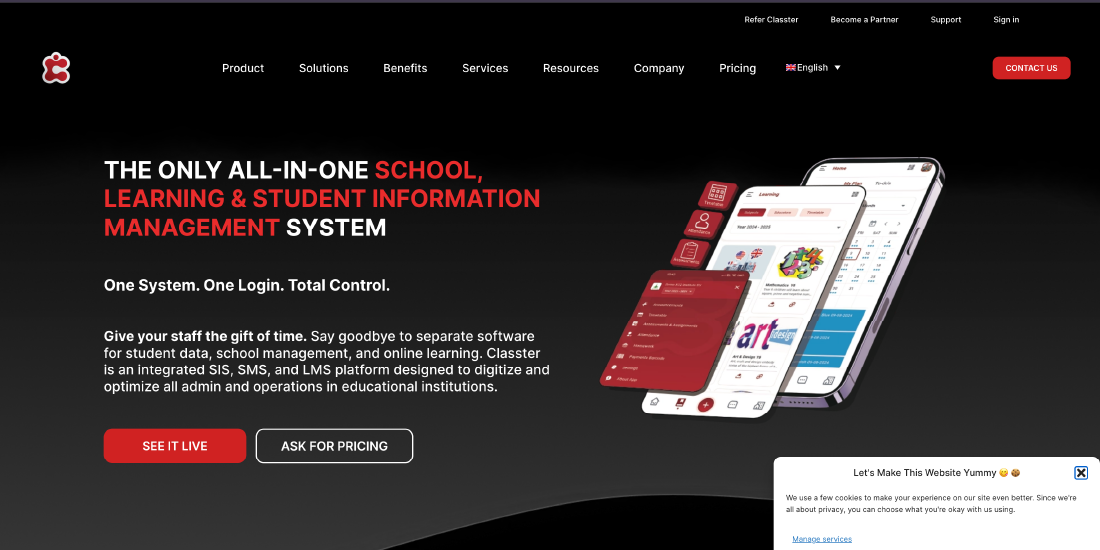
Key Features:
- AI-driven predictive analytics for student success
- Centralized management of academics, admissions, and finance
- Cloud-native scalability for institutions of any size
Best For:
Global higher education institutions seeking automation, analytics, and full-cycle student lifecycle management.
Pricing Model:
Modular, per-active-student pricing.
Fedena
Fedena is a customizable, open-source school and college management system offering over 100 modules, including academics, finance, transport, hostel, and HR.

Key Features:
- Open-source design for deep customization
- Modules for hostel, transport, and library management
- Scalable for institutions of any size
Best For:
Schools, colleges, and universities seeking high customizability and control over their digital infrastructure.
Pricing Model:
Tiered annual pricing with unlimited users.
eSkooly
eSkooly is a fully free, cloud-based school management system offering a broad range of administrative tools from admissions and attendance to exam and fee management. Despite being free, it provides enterprise-grade functionality suitable for smaller institutes.
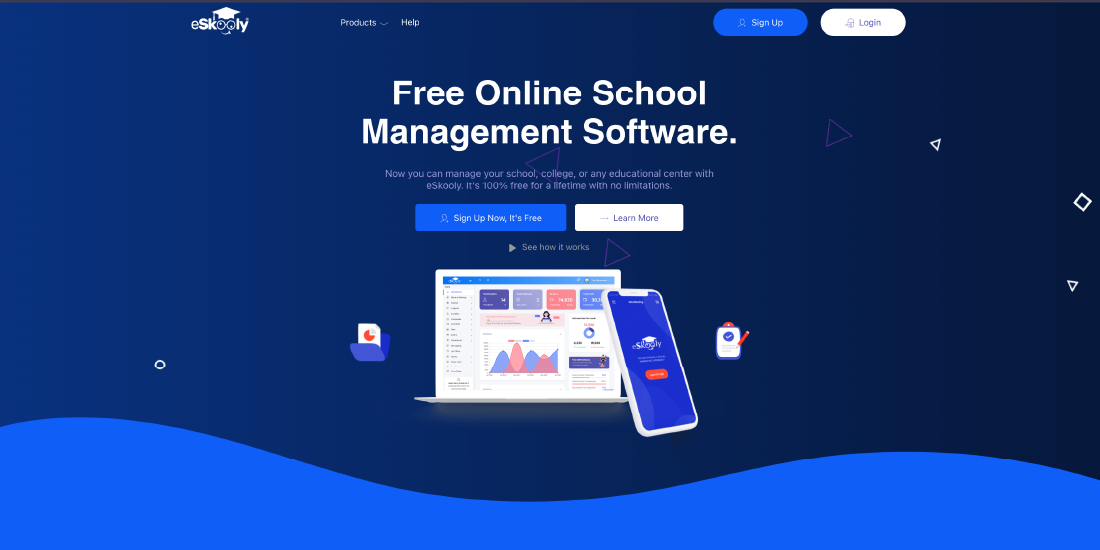
Key Features:
- Covers all administrative essentials with zero cost
- Unlimited users and cloud storage
- Simple user interface with easy onboarding
Best For:
Training institutes, community learning centers, and budget-conscious institutions seeking a full-featured yet free platform.
Pricing Model:
Completely free, with lifetime access and no usage restrictions.
| Software | Best For | Core Focus | Mobile App | Pricing Model |
| PowerSchool | Large K-12 Districts | SIS / LMS / ERP | Yes | Custom Quote |
| Infinite Campus | K-12 Districts | SIS & Reporting | Yes | Custom Quote |
| Skyward | Public Schools | SIS & ERP (Finance / HR) | Yes | Custom Quote |
| Frontline Education | HR & Operations | HCM & Absence Mgmt | Yes | Custom Quote |
| Alma | Mid-Sized K-12 | SIS & Classroom Mgmt | Yes | Custom Quote |
| Gradelink | Small Private Schools | Core SIS (Grades / Attendance) | Yes | Per Student / Month |
| Blackbaud | Private K-12 | Enrollment & Financials | Yes | Tiered / Custom |
| QuickSchools | Small to Mid-Sized | Core SIS (Modular) | Yes | Per Student / Month |
| MySchoolWorx | Faith-Based / Small | Communication & SIS | Yes | Custom Quote |
| DreamClass | Specialty / Micro-Schools | Class & Enrollment Mgmt | Yes | Tiered |
| Ellucian Banner | Universities | ERP & Student Lifecycle | Yes | Enterprise Quote |
| Canvas LMS | Learning & Instruction | LMS | Yes | Free / Custom |
| Classter | Global Institutions | ERP / AI Analytics | Yes | Modular |
| Fedena | Custom Institutions | ERP (Open-Source) | Yes | Tiered Annual Fee |
| eSkooly | Budget Schools | Core SIS | No | Free |
How Higher Education Institutions Can Choose the Right Student Management Tools
Selecting the right student management tools is a crucial decision that influences every aspect of a higher education institution — from enrollment and academic management to compliance and student engagement. To make an informed choice, universities and colleges should focus on systems that are:
- Flexible and Configurable: Adapt easily to evolving academic programs, institutional policies, and diverse course requirements.
- Cloud-Based (SaaS): Offers seamless updates, lower maintenance costs, and ongoing access to new features. Nearly 65% of SIS implementations in 2025 use cloud-based models, highlighting the shift toward subscription-based, low-maintenance solutions.
- Secure and Compliant: Protect sensitive student data through strong security measures and compliance with regional, state, and federal regulations. Cybersecurity-focused SIS adoption has grown by around 90%, reflecting the rising importance of data protection.
- Highly Integrable: Work smoothly with existing systems such as ERP, LMS, CRM, and analytics platforms to create a unified data ecosystem. Institutions using integrated platforms for student lifecycle management reported a 10% increase in graduation rates through data-driven interventions.
Conclusion
Selecting the right student management system is crucial for modern educational institutions looking to streamline campus operations, improve academic outcomes, and strengthen student engagement. From centralized administration and real-time communication to data-driven decision-making and secure IT management, these systems help schools and universities operate more efficiently and make informed decisions. By adopting advanced management tools, institutions can reduce administrative workload while creating a more connected, supportive, and future-ready learning environment.
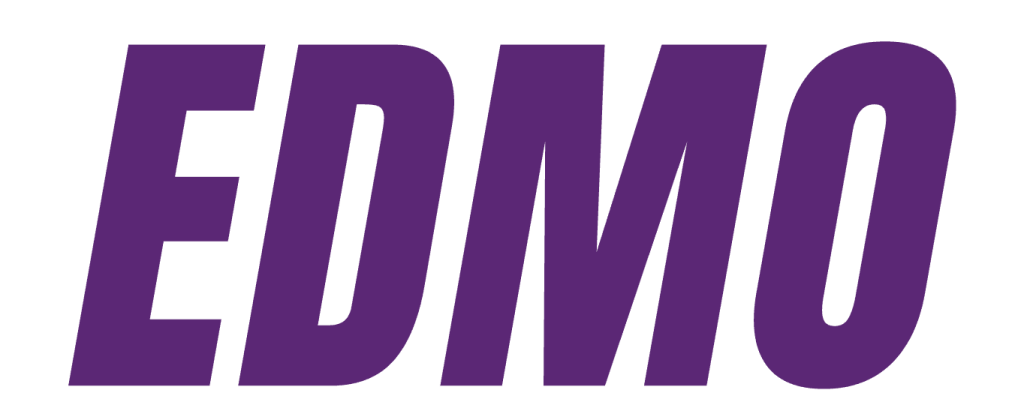






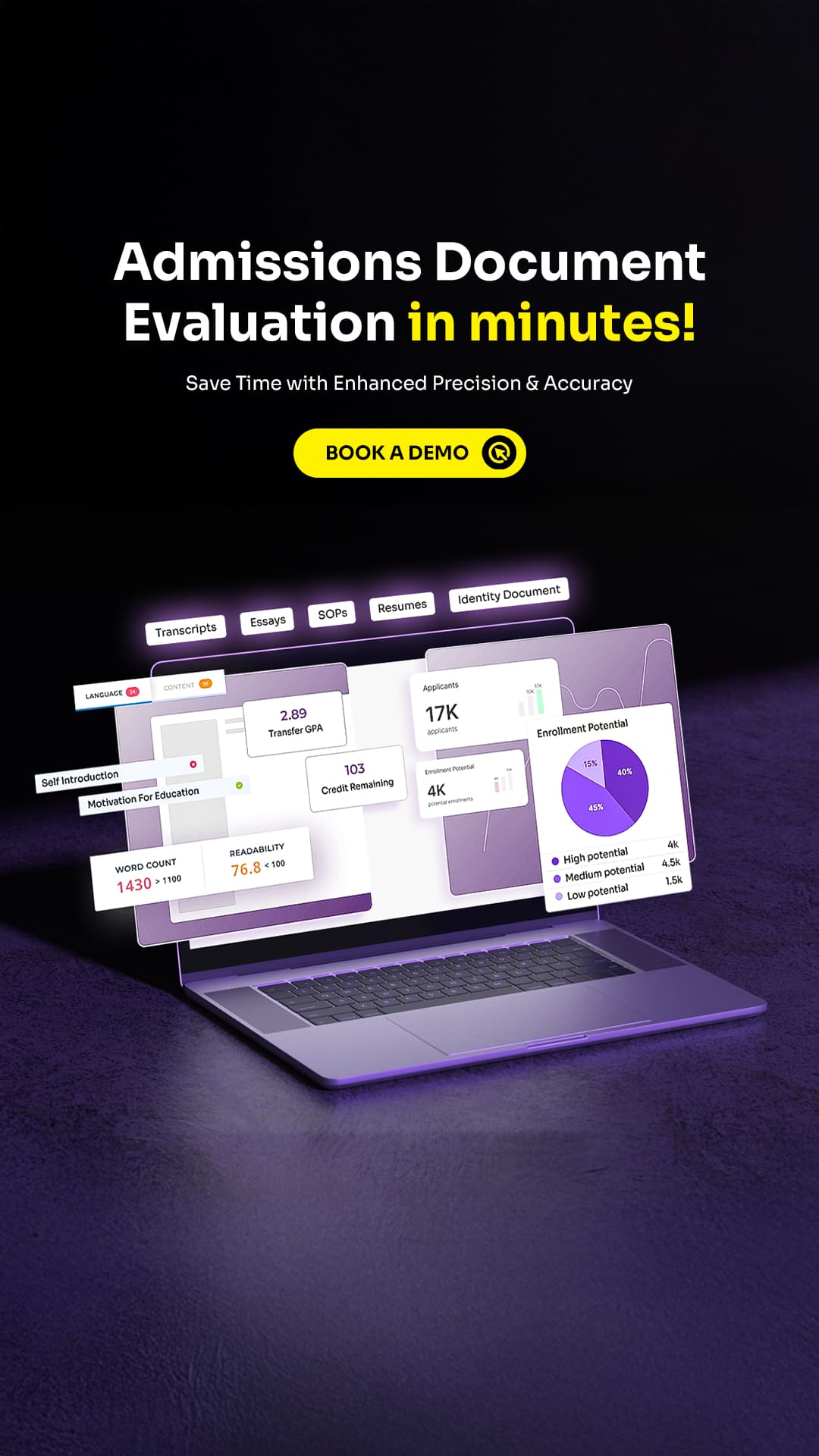
No comments yet. Be the first to comment!
Leave a Comment